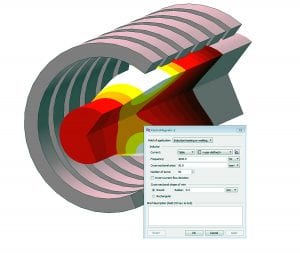
Simufact, an MSC software company, has announced the release of the next generation of its software solution, Simufact Forming 15, for the simulation of forming manufacturing processes. Users will now be able to simulate inductive heating processes as well as case hardening. One key new feature is the interface to the casting software Magmasoft® 5.4, which, in addition to the already existing ProCAST interface, pushes forward the idea of the process chain simulation. Results imported from the casting simulation via the Magma interface in Simufact Forming 15 for subsequent forming processes in the design cycle. With the added parallelizable Segment-to-Segment calculation method in the new solver, Simufact Forming 15 is now able to simulate large models with deformable bodies faster and more efficiently.
Inductive heating is used in many areas of industrial manufacturing, including heating of workpieces to forming temperature, induction hardening, and induction welding. Users can now optimize and design parts with inductive heating processes and subsequent hardening processes.
Simufact Forming helps design engineers gain a detailed insight into an inductive heating process. Users can identify errors, remove unwanted effects, and make optimizations. In designing the coil, for example, which is the core challenge of inductive heating. Simufact Forming 15 presents users with the complexity of physical context.
The required electromagnetic material properties needed for these types of workflow can be imported by the extended JMatPro interface.
Case hardening is one of the most widespread and important heat treatment processes. Dies, drive parts, or gear parts (gears) are often case hardened at the end of the manufacturing process to combine a wear-resistant surface with a tough behavior in the core. Simufact Forming Version 15 extends the functions of simulating heat-treatment processes in order to make practical use of the diffusion effects in case hardening. With the new version, it is now possible to calculate the adjusting carbon distribution that results during the carburizing below the surface of the component, and allows for the influence of this carbon profile on the transformation behavior during quenching.
The newly implemented contact positioner and significantly improved positioning options simplify the positioning of the workpiece and the tools. With the query results function (querying values), engineers can selectively record and determine result quantities. With the newly implemented user coordinate system, users can compare their simulated component with the target design or with 3D measurement data as a reference model. With the current version, Simufact introduces a re-implemented fast and automated fold detection feature that greatly simplifies the detection of folds, which is specifically useful for hot forging.
MORE INFORMATION www.simufact.com






















